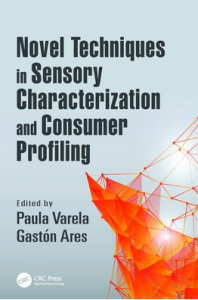Check-All-That-Apply questions
 Sensory characterization is one of the most powerful, sophisticated, and extensively applied tools in sensory science. Descriptive analysis with trained assessors has been traditionally used for sensory characterization. Due to the cost of time and money required for its application, several novel methodologies, which do not require training, have been recently developed and are gaining popularity as quick and reliable options for gathering sensory information. These methodologies enable the study of consumers’ perceptions of the sensory characteristics of products. However, information on these techniques is scattered in scientific journal articles, which hinders their application and creates a need for a book to assemble the details of the latest advances.
Sensory characterization is one of the most powerful, sophisticated, and extensively applied tools in sensory science. Descriptive analysis with trained assessors has been traditionally used for sensory characterization. Due to the cost of time and money required for its application, several novel methodologies, which do not require training, have been recently developed and are gaining popularity as quick and reliable options for gathering sensory information. These methodologies enable the study of consumers’ perceptions of the sensory characteristics of products. However, information on these techniques is scattered in scientific journal articles, which hinders their application and creates a need for a book to assemble the details of the latest advances.
Novel Techniques in Sensory Characterization and Consumer Profiling provides a comprehensive overview of classical and novel methods for sensory characterization of food and nonfood products. The book presents the history behind descriptive analysis, describes the most common novel methodologies and detailed information for their implementation, and discusses examples of applications and case studies. It also includes an introduction to exploratory multivariate analysis, addressing the theory and application of some of the most useful multivariate statistical tools applied in the analysis of consumer profiling data sets.
Most of the data analysis is implemented in the statistical free software R, making the book accessible to readers unfamiliar with complex statistical software.
Chapters examine a range of techniques including the ideal profile method, just-about-right scales in consumer research, free choice profiling, flash profiling, and repertory grid methods. They cover emerging profiling methods, such as sorting, and projective mapping or Napping®. Other techniques less frequently used for sensory profiling are also considered: the application of open-ended questions for sensory characterization, polarized sensory positioning, and the consumer-friendly check-all-that-apply questions. In addition, dynamic sensory characterization methods, useful for studying temporal aspects of in-mouth sensory perception, are described. The final chapter provides a critical comparison of the methodologies discussed, their advantages and disadvantages, and general recommendations for their application.
![]()
Meyners, M., & Castura, J. C. (2016). Check-All-That-Apply questions. In P. Varela and G. Ares (eds.): Novel techniques in sensory and consumer profiling, 271-306. Boca Raton, FL: CRC Press.